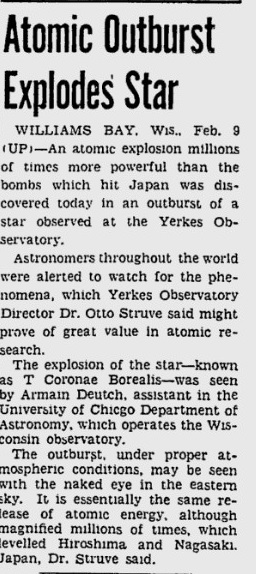
Yerkes Observatory. Wikipedia image.
 On this day 75 years ago, persons on Earth were able to witness a star going nova. In particular, the star T Coronae Borealis went from being a 10th magnitude star, barely visible with binoculars, to a magnitude 3.0. There were still 120 objects in the sky that were brighter, but for a few days, it was visible to the naked eye on February 9, 1946.
On this day 75 years ago, persons on Earth were able to witness a star going nova. In particular, the star T Coronae Borealis went from being a 10th magnitude star, barely visible with binoculars, to a magnitude 3.0. There were still 120 objects in the sky that were brighter, but for a few days, it was visible to the naked eye on February 9, 1946.
This news account appeared in the Pittsburgh Press, February 9, 1946. It reported that the “atomic explosion millions of times more powerful than the bombs which hit Japan” was first observed by Arman Deutch of the University of Chicago Department of Astronomy at the Yerkes Observatory in Williams Bay, Wisconsin.
The star is a recurring nova. It’s actually a binary system containing a large cool component and a smaller hot component. The cool component, a red giant, is transferring material to the hot white dwarf component. During outbursts, the transfer of material increases, thus increasing the overall luminosity.
The star had a brightening in 2016, which is said to be similar to a 1938 brightening that preceded the 1946 outburst. It is said to remain at an unusually high level of activity.
